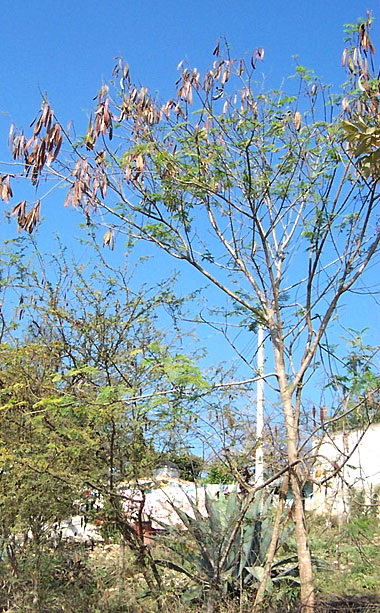Excerpts from Jim Conrad's
Naturalist Newsletter
from the March 3, 2007 Newsletter issued from Sierra Gorda Biosphere Reserve, QUERÉTARO, MÉXICO
WILD TAMARIND/ GUAJE
The other day Don Gonzalo ambled past my door nibbling on a thin, flat bean pod. You can see the whole thing below:

The Don flashed that big smile of his and asked me if I knew what he was eating. I surprised him by saying, "Sure, that's Guaje (GWA-heh), grows all over the place." I only knew this because Guaje, LEUCAENA LEUCOCEPHALA, was one of the most common roadside trees back in the Yucatan, where the Maya called it Uaxim (WA-sheem). In English it has a host of names, including Leadtree, White Popinac and Wild Tamarind.
This is the very season for nibbling Guaje beans, for the full-size beans are soft only for a brief time. Most of the year the trees with their twice-compound (bipinnate) leaves bear neither flowers nor fruits, or have only flowers, or else the fruits' matured seeds are too hard to eat. Now Guaje trees are heavy with soft-seeded, semi-mature legumes, as you can see below:

That picture also gives a good idea of the ragged appearance of many trees in our area right now, here in the heart of the dry season: Mostly leafless, but with a few old leaves, and a few new leaves, and often loaded with brown fruit pods.
Semi-mature Guaje seeds such as Don Gonzalo is eating have a sharp, almost bitter taste you need to be in a particular mind to enjoy. A kid wouldn't bother with it. However, good cooks know how to use the pungency when preparing special soups and sauces. On the Internet I find a gourmet site praising a meal of "Gunthorp duck breast with guasmole (Pueblan mole of roasted tomatillos and guaje seeds), bacon-studded sweet potato torta and cava-dressed Bayless Garden spicy greens."
I'll bet Don Gonzalo would sniff at such fancy fare, preferring his Guaje beans straight from the pod, and I have to say that I'm of the same mind.